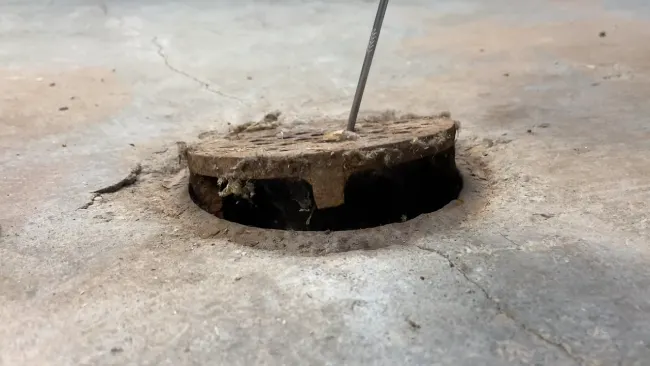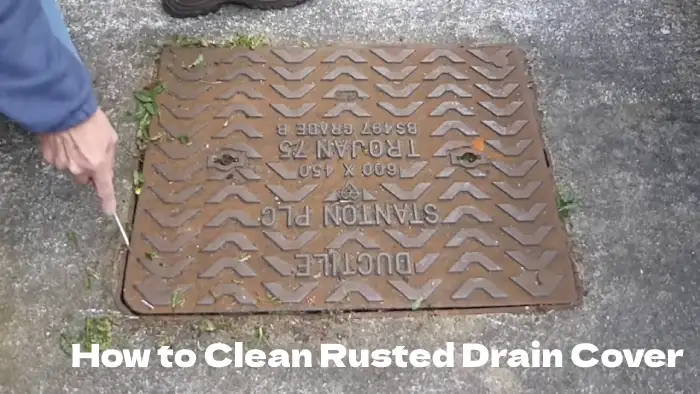Last Updated on June 8, 2023
Drain covers are essential for a plumbing system, preventing debris and hair from entering the drain pipes. Over time, these covers can become rusty and unsightly, affecting the overall look of your bathroom or kitchen. So how to clean a rusted drain cover without damaging it?
For both metal and plastic covers, there are simple steps you can follow. Ensure to take safety precautions. After that, remove the cover to examine the affected area. Assess the level of rust before selecting an appropriate cleaning solution. Vinegar or lemon juice can be effective options.
If the cover is metal, use a wire brush to scrub away the rust, being careful not to scratch or damage the surface. For plastic covers, opt for a softer brush or sponge to remove loose particles, and rinse thoroughly.
Throughout this article, we are going to walk you through the steps to clean rusted drain covers effectively. Let’s get started.
Steps on How to Clean Rusted Drain Cover & Prevent Rusting

Drain cover cleaning requires some care and attention. If you’re not careful, you can damage the cover further. To clean a rusted drain cover, whether it is made of metal or plastic, you can follow these steps:
For Cleaning a Metal Drain Cover (after following the above 3 steps):
- Step 04: Scrub with a Wire Brush
- Step 05: Apply Vinegar or Lemon Juice
- Step 06: Scrub Again and Rinse
- Step 07: Dry and Prevent Future Rust
For Cleaning a Plastic Drain Cover (after completing 1 to 3 steps above):
- Step 04: Create a Cleaning Solution
- Step 05: Scrub with a Soft Brush or Sponge
- Step 06: Rinse Thoroughly
- Step 07: Dry and Maintain
Step 01: Safety First
Wearing protective gear such as gloves and safety goggles is essential before starting any cleaning activity. Gloves will shield your hands against sharp edges that could cause cuts or injury.
On the other hand, safety goggles protect your eyes from dust particles and debris that may fly around during the cleaning process.
Step 02: Remove the Drain Cover
Now you should go for removing the drain cover. Depending on the type of drain cover, you may have to use a screwdriver or a wrench to remove the bolts or screws holding it in place.
If the bolt or screw is rusted, you may need to use a lubricant such as WD-40 to loosen it. It will allow you to remove the drain cover easily.
Step 03: Inspect the Rust
Before starting any cleaning or maintenance procedures on the drain cover, thoroughly inspect the level and extent of rust present. This inspection aids us in determining the severity of the rust damage and helps us decide whether cleaning or replacement is necessary.
A comprehensive and detailed examination of the rust is required to identify its type, location, and extent. This information is essential in selecting the appropriate method for rust removal.
Depending on the material of the drain cover, the next steps are different.
For Cleaning a Metal Drain Cover:
Step 04: Scrub with a Wire Brush

To effectively eliminate rust particles and recover a metal surface’s smoothness, scrubbing it with a wire brush is crucial. The circular motion should cover all rusted areas thoroughly, applying sufficient pressure for optimal results.
When cleaning drain covers, a wire brush can reach narrow crevices and ridges. This tool’s effectiveness lies in penetrating small spaces that other cleaning tools may fail to access.
Step 05: Apply Vinegar or Lemon Juice
Using a wire brush to scrub off your drain cover may leave some rust spots. Applying a natural acid like lemon juice or vinegar can remove these. They dissolve rust and help to eliminate any remaining stains on the cover.
Place the drain cover in a container filled with either liquid to apply the vinegar or lemon juice. Allow the cover to sit for several hours or overnight. During this time, the acid will loosen the rust, making it easier to scrub away afterward.
Step 06: Scrub Again and Rinse
After soaking the drain cover thoroughly, remove it from the container and give it one final scrub using a wire brush. Scrubbing it again with a wire brush will help to eliminate any remaining rust particles that may have been missed during the initial cleaning process.
After scrubbing, rinse the drain cover thoroughly with water to remove any traces of acid.
Step 07: Dry and Maintain
After thoroughly scrubbing the rusted drain cover and giving it a final rinse, ensure it is completely dry before proceeding. Let the cover air dry, or pat it dry with a towel. Failure to do so could result in water stains or even more rust forming on the metal surface.
Several measures you can take to prevent future rust from forming on the metal drain cover. One option is to apply a thin coat of rust-resistant paint onto the surface of the metal.
Another option is using a rust inhibitor specifically designed for metal surfaces to create a protective barrier against moisture and oxygen.
For Cleaning a Plastic Drain Cover:
Step 04: Create a Cleaning Solution
After step 3, the initial step in the maintenance process involves preparing a solution to clean a rusted plastic drain cover. Mix warm water with a mild dish soap or multi-purpose cleaner in a bucket or basin to do this.
Use warm water as it helps break down and dissolve the dirt and grime accumulated on the drain cover’s surface. The cleaning solution should be prepared carefully to ensure it effectively removes all traces of rust and other debris from the drain cover.
Step 05: Scrub with a Soft Brush or Sponge
Use a soft-bristle brush or sponge to scrub the rusted areas of the plastic drain cover. You need to apply some pressure but try to avoid scratching or damaging the plastic.
When scrubbing with a soft brush or sponge, ensure that you have dipped it into the cleaning solution beforehand. The cleaning solution will help loosen and remove any accumulated rust on the drain cover over time.
Step 06: Rinse Thoroughly
After removing rust with a brush or sponge, rinse the drain cover meticulously with clean water. This step eradicates any residual rust particles and cleaning agent left after scrubbing, leaving a clean and hygienic surface.
Besides this, thorough rinsing prevents future corrosion by removing all remaining rust particles and cleaning solution residue.
Step 07: Dry and Maintain
After rinsing the drain cover thoroughly, dry it completely before reattaching it back onto the drain. Let it air dry, or wipe it dry with a towel.
In addition to drying, maintaining the plastic drain cover can also help prevent rust from forming in the future. Avoid using abrasive cleaners or rough brushes on the surface of the cover, as these may cause scratches and damage to its surface. Instead, opt for gentler cleaning solutions such as soap and water.
Say Goodbye to Rusty Drain Covers with Simple Cleaning Methods

Maintaining a clean and functional drain is essential to prevent water buildup, foul odors, and potential blockages. And cleaning rusted drain covers is a simple process that requires some basic household items.
To start with, remove the drain cover from the sink or bathtub to inspect for rust. Select an effective natural cleaning solution, such as vinegar or lemon juice. Use a wire brush for metal covers and a soft brush for plastic ones. After you scrub, make sure to rinse well.
And dry the cover and maintain it with regular cleaning sessions to prevent any further rusting. Follow these steps to keep your drain covers looking as good as new.

